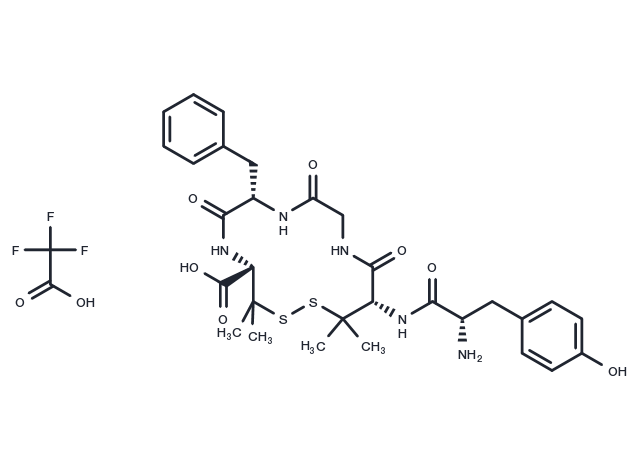keep away from moisture
Powder: -20°C for 3 years | In solvent: -80°C for 1 year

DPDPE TFA is selective δ-opioid receptor agonist peptide. Inhibits electrically stimulated contraction of mouse vas deferens in vitro (EC50 = 5.2 nM), and is antinociceptive in vivo.

| Pack Size | Availability | Price/USD | Quantity |
|---|---|---|---|
| 1 mg | In stock | $ 113.00 | |
| 5 mg | In stock | $ 272.00 | |
| 10 mg | In stock | $ 413.00 | |
| 25 mg | In stock | $ 676.00 | |
| 50 mg | In stock | $ 943.00 | |
| 100 mg | In stock | $ 1,270.00 |


| Description | DPDPE TFA is selective δ-opioid receptor agonist peptide. Inhibits electrically stimulated contraction of mouse vas deferens in vitro (EC50 = 5.2 nM), and is antinociceptive in vivo. |
| Synonyms | DPDPE TFA |
| Molecular Weight | 759.81 |
| Formula | C32H40F3N5O9S2 |
| CAS No. | 172888-59-4 |
keep away from moisture
Powder: -20°C for 3 years | In solvent: -80°C for 1 year
DMSO: 10 mM
You can also refer to dose conversion for different animals. More
bottom
Please see Inhibitor Handling Instructions for more frequently ask questions. Topics include: how to prepare stock solutions, how to store products, and cautions on cell-based assays & animal experiments, etc.
DPDPE TFA (88373-73-3 free base) 172888-59-4 Endocrinology/Hormones GPCR/G Protein Neuroscience Opioid Receptor DOR Inhibitor DPDPE inhibit 88373-73-3 DPDPE TFA (88373733 free base) anticonvulsant DPDPE TFA (88373 73 3 free base) DPDPE TFA agonist 88373-73-3 free base inhibitor
